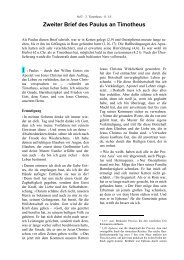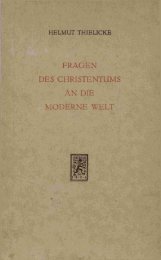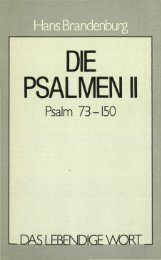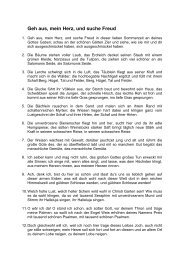You also want an ePaper? Increase the reach of your titles
YUMPU automatically turns print PDFs into web optimized ePapers that Google loves.
a) A small cube lies in the corner of a room or is<br />
fixed to the ceiling.<br />
b) A small cube is placed in front of the larger<br />
one, at one corner.<br />
c) Similar to b), but now there is a cubical hollow<br />
in one corner of the large cube.<br />
And what do we see in Figure 4? A young woman<br />
or an old one? Both are possible. This is also an<br />
example of an illusion of perception.<br />
John Eccles draws conclusions from these. Even<br />
though a diagram can be interpreted in more<br />
than one way, we can be sure of one thing: there<br />
is only a single, unambiguous image on the retina<br />
which is then electrically transmitted to the<br />
brain. Here the optical image corresponds to a<br />
precisely defined neuronal connection – whatever<br />
form that may take. From this Eccles<br />
deduces the existence of another independent<br />
entity which observes and interprets the actual<br />
brain connections. He calls this interpreter the<br />
mind (others might call this the soul).<br />
Brain and mind can exchange information, but<br />
the mind has the freedom to interpret one specific<br />
picture in various ways. This dualism is illustrated<br />
graphically in Figure 6 (World 1 and World<br />
2). World 1 represents the required material part<br />
– the brain, and World 2 depicts the nonmaterial<br />
Mind<br />
External <strong>sense</strong><br />
Experiencing<br />
Light<br />
Colour<br />
Sounds<br />
Smells<br />
Pain<br />
Touch<br />
Inner <strong>sense</strong><br />
External ➨<br />
information ➨<br />
through ➨<br />
the ➨<br />
<strong>sense</strong> ➨<br />
<strong>organs</strong> ➨<br />
Source<br />
of<br />
information<br />
Brain<br />
(Intelligence)<br />
➮ Knowledge<br />
➮ Inventions<br />
➮ Fantasy<br />
➮ Programs<br />
➮ Encoding systems<br />
➮ Strategies<br />
➮ Concepts<br />
➮ Ideas<br />
➮ Plans<br />
➮ Thoughts<br />
➮ Goal setting<br />
World 1 World 2<br />
myself<br />
mind<br />
will<br />
Liaison brain<br />
Thoughts<br />
Feelings<br />
Memories<br />
Dreams<br />
Imaginings<br />
Intentions<br />
Figure 5: The interactions between brain and mind<br />
according to the dualistic view of man.<br />
Figure 6: The dualistic view of man. On the one side we<br />
have the material aspects (the body with all its anatomical<br />
details), and on the other side is the non-material<br />
part (the I, the self, the mind, and the will). Eccles postulates<br />
the presence of a liaison brain, which is “observed”<br />
and interpreted by the non-material part.<br />
93
















